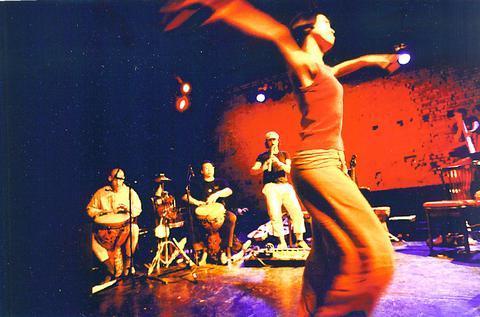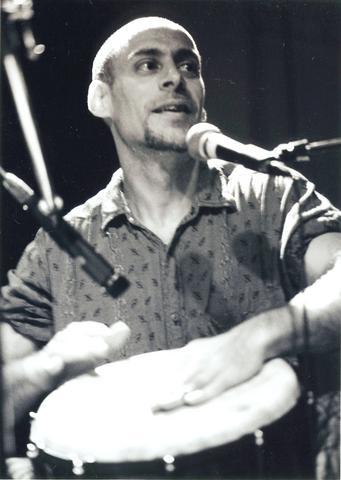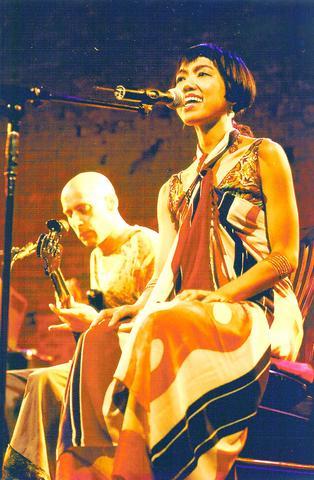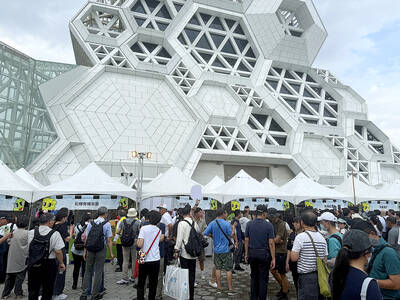Scott Prairie and Mia Hsieh (
"It involves finding your own improvisational ideas, but then having a point of contact," Prairie explained, then demonstrated by tapping Hsieh on the arm.

PHOTOS COURTESY OF ALBERTO BUZZOLA
"It's about energy following reasoning," Hsieh said, picking up where Prairie left off.

If you don't follow the reasoning, don't worry, it's easier to follow Hsieh and Prairie's energy.
What started as a bump at that New York City workshop blossomed into a friendship, a creative collaboration, a marriage and, more recently, A Moving Sound (

The sound it serves up is best described by its ingredients. Prairie trained in classical music on the French horn but gave it up for psychology. Hsieh came to singing and dancing by way of theater administration. By the time Prairie met Hsieh, he had already gone back to music and bought a bass guitar that he'd retuned to get the effect he wanted. By the time she met Prairie, Hsieh had already stopped administering theater troupes in Taiwan to explore her own creativity in New York as part of a Fulbright scholarship.
Prairie tells of how Hsieh found her voice at a vocalization workshop at New York City's CBGB, after which the workshop organizers held an impromptu contest.
"The contest was yodeling," Prairie said. "Somebody dragged Mia on stage with all these crazy vocalists taking their turn. And when it came her turn she said `What is yodeling?' ... So somebody yodeleheehooed -- put it in her ear. She just let it fly and won the contest."
Her prize, she learned later, was six weeks of voice lessons with a contemporary of Meredith Monk, the pioneer of "extended vocal technique," whose work intersects music and movement.
"Before that, most of my experience was dance" in Taiwan, Hsieh said.
Like Monk, Hsieh became interested in the combination of voice and movement. Her interest was the seed that later sprouted into her and Prairie's sister project, A Moving Sound Theater. In their musical collaborations, Hsieh will construct a vocal narrative to melodies that Prairie has written, Several of Little Universe's tracks are sung in a language Hsieh has improvised, though you have to listen closely before realizing as much. Movement is used to help move the narrative, or else to involve the audience, give them instruments or get them dancing.
But they're hardly alone in their collaboration, be it for music or theatre. A Moving Sound is joined by percussionists Alex Wu (
The quintet actually finished recording Little Universe in November of last year (It was reviewed in Taipei Times' May 9 issue of this year under its original title, Pacu's Trip) In the past year, they toured the album through several US cities -- including Los Angeles, Seattle, Portland, New York and Pittsburgh, as well as performing at the Asian Acoustic Music Festival back in Taiwan and regular appearances at the Red Theater and Wisteria Tea House, to name a few.
Their sound combines a world of elements. It's Indian-spiced and Middle-Eastern flavored. It employs African rhythms and often has the texture of Taiwanese Aboriginal music. It's eclectic, but has a universality that keeps you humming along with it.
"We like to experiment with new combinations," Prairie said. An example?
"We have one girl joining us for next week's show who is a trained circus performer who's here studying Chinese opera. She'll perform while hanging from the ceiling on a piece of cloth."
A MOVING SOUND'S LITTLE UNIVERSE
TAIPEI
Thursday, Dec. 16 @ 7:30pm
Red Theater, 10 Chengdu Rd, Ximending, Taipei (紅樓劇場 北市成都路10號). Tickets NT$400, available at the door.
TAINAN
Saturday, Dec. 18 @ 4:30pm
Eslite Bookstore Square, Tainan (台南誠品書店戶外廣場 南市東區長榮路一段181號)
Free admission
Saturday, Dec. 18 at 7:26pm, 726 Art Space, Hai-an Rd. and Hopin St, Tainan (台南七二六劇場/台南市海安路&和平街口)
Free Admission
KAOHSIUNG
Sunday, Dec. 19 at 2pm, Eslite Bookstore, 21 Sanduo Fourth Rd, 17F, Kaohsiung (高雄誠品大遠百店/高雄市苓雅區三多四路21號17F)
Free admission
Sunday, Dec. 19 at 4pm, Pier 2 Art Districts, 1 Tayung Rd, Yencheng District, Kaohsiung (高雄駁二藝術特區高雄市鹽埕區大勇路1號).
Free Admission

Following the shock complete failure of all the recall votes against Chinese Nationalist Party (KMT) lawmakers on July 26, pan-blue supporters and the Chinese Communist Party (CCP) were giddy with victory. A notable exception was KMT Chairman Eric Chu (朱立倫), who knew better. At a press conference on July 29, he bowed deeply in gratitude to the voters and said the recalls were “not about which party won or lost, but were a great victory for the Taiwanese voters.” The entire recall process was a disaster for both the KMT and the Democratic Progressive Party (DPP). The only bright spot for

Water management is one of the most powerful forces shaping modern Taiwan’s landscapes and politics. Many of Taiwan’s township and county boundaries are defined by watersheds. The current course of the mighty Jhuoshuei River (濁水溪) was largely established by Japanese embankment building during the 1918-1923 period. Taoyuan is dotted with ponds constructed by settlers from China during the Qing period. Countless local civic actions have been driven by opposition to water projects. Last week something like 2,600mm of rain fell on southern Taiwan in seven days, peaking at over 2,800mm in Duona (多納) in Kaohsiung’s Maolin District (茂林), according to

Aug. 11 to Aug. 17 Those who never heard of architect Hsiu Tse-lan (修澤蘭) must have seen her work — on the reverse of the NT$100 bill is the Yangmingshan Zhongshan Hall (陽明山中山樓). Then-president Chiang Kai-shek (蔣介石) reportedly hand-picked her for the job and gave her just 13 months to complete it in time for the centennial of Republic of China founder Sun Yat-sen’s birth on Nov. 12, 1966. Another landmark project is Garden City (花園新城) in New Taipei City’s Sindian District (新店) — Taiwan’s first mountainside planned community, which Hsiu initiated in 1968. She was involved in every stage, from selecting

The latest edition of the Japan-Taiwan Fruit Festival took place in Kaohsiung on July 26 and 27. During the weekend, the dockside in front of the iconic Music Center was full of food stalls, and a stage welcomed performers. After the French-themed festival earlier in the summer, this is another example of Kaohsiung’s efforts to make the city more international. The event was originally initiated by the Japan-Taiwan Exchange Association in 2022. The goal was “to commemorate [the association’s] 50th anniversary and further strengthen the longstanding friendship between Japan and Taiwan,” says Kaohsiung Director-General of International Affairs Chang Yen-ching (張硯卿). “The first two editions